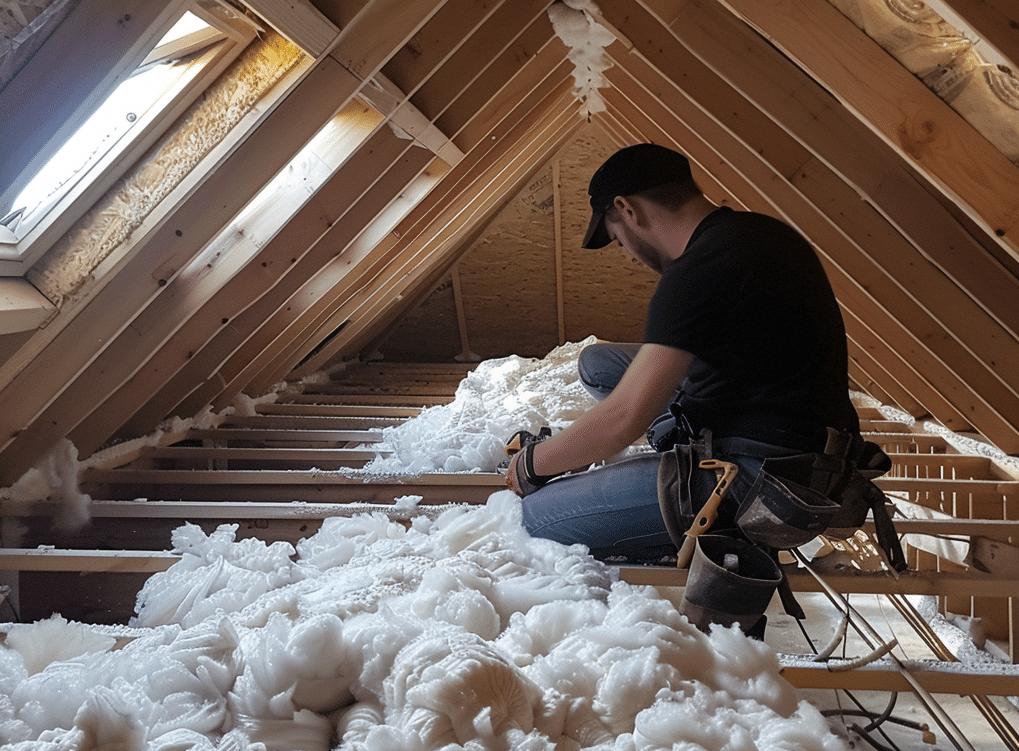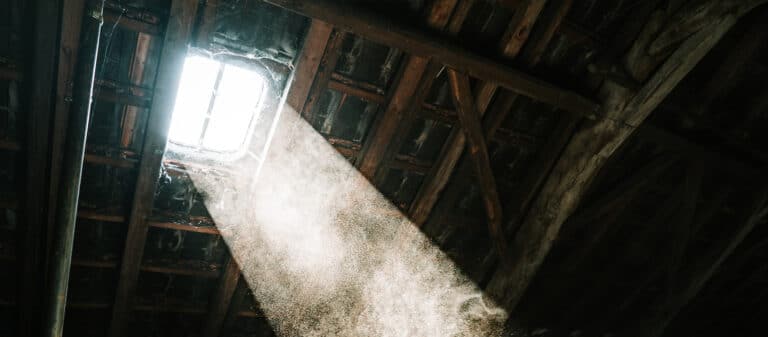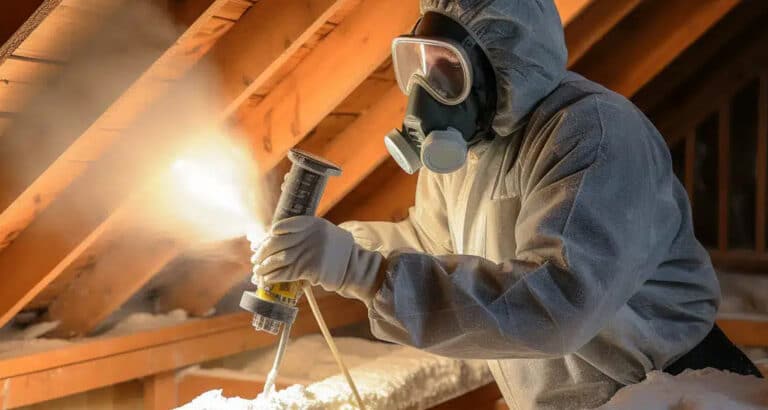When beginning any insulation project, we recommend starting in the attic.
The reasons are simple – savings!
According to data from Remodeling magazine, the ROI of insulating your attic can total over 100% at resale.
Not only does attic insulation deliver the biggest bang for your buck, but an insulation project can be completed DIY, depending on the materials you choose.
No worries; we’ve got you covered. Here’s a guide that discusses the best way to insulate your Northeast Pennsylvania attic, ensuring you save on heating bills during the colder months.
DIY vs. Professional Installation (Pros and Cons)
Once you decide to insulate your attic, you will need to decide whether or not it makes sense to hire a professional insulation contractor.
Depending on your existing insulation, professional assistance may be required to remove old attic insulation, including moldy fiberglass batts or loose fill.
You can add new insulation over old insulation pretty easily, especially if you’re applying a new fiberglass roll over an old roll, batt, or loose fill.
However, the choice to hire a professional or insulate an attic on your own will depend on a few key factors:
- Budget: Can you afford to hire a professional to complete a job? Remember that you will also have to pay for all materials on your own, including installation equipment, if you go DIY.
- Insulation Materials: Most DIY attic projects are completed using fiberglass rolls that are easy to cut and shape. However, you will require professional assistance if you want an insulation material with a higher R-value, such as spray foam or cellulose. Learn more about insulation R-value.
To help you decide which approach makes the most sense for your home or business, we’ve outlined a few pros and cons to keep in mind.
|
Pros |
Cons |
|
|
Professional |
|
|
|
DIY |
|
|
The Best Time of Year to Insulate an Attic
Attic insulation should be performed during moderate temperatures, such as in the Spring or Fall in Northeast PA.
These times of year will allow the installer to avoid extreme conditions and eliminate any potential issues they may run into with moisture during installation.
Performing an Energy Audit
Before embarking on an attic insulation project, it’s essential to conduct an energy audit to identify heat loss areas and determine the most effective insulation solutions. One benefit of working with a professional installer is they can perform this audit for you to uncover additional cost-saving opportunities.
Using professional equipment, such as a blower door test, will allow the installer to identify existing insulation deficiencies or pinpoint air leaks where additional insulation needs to be applied.
How to Choose the Right Insulation Material
EnergyStar recommends that homes with uninsulated attics in Northeast PA install insulation with an r-value of R-60.
Depending on the type of material you use, you will need to calculate the width of the material being installed to reach an R-60 value.
For example, closed-cell spray foam with an average value of R-6-per-inch would require 10 inches of thickness to reach your desired insulation level. On the other hand, cellulose with an R-value of R-3.1 would require almost 20 inches of thickness to reach your intended R-value.
For this reason, the type of material you use will impact its efficiency and overall cost. While cellulose may seem cheaper than spray foam, if you’re trying to reach an R-value of R-60, the prices will be closer than you think.
For the most part, you have three options for insulating an attic in NEPA to its intended R-value.
- Spray Foam (Closed or Open-Cell): Closed-cell spray foam offers the best bang for its buck and is generally the most efficient and longest-lasting material you can purchase.
- Fiberglass (Batt or Fill): Cost-effective and readily available, fiberglass insulation can help you reach your intended R-value and offer long-lasting efficiency. Batts or rolls are also easier to install DIY.
- Cellulose: Made from recycled paper or plant fibers, cellulose is an efficient and affordable option, though it tends to only last about 25 years. [Learn More: Best Insulation Materials for Cold Weather in Scranton]
How to Insulate An Attic
Now that you have performed an energy audit and selected the right insulation material, it’s time to draft a plan of action to insulate your attic.
Performing an Air Seal
Before installing insulation, it’s crucial to air seal the attic to prevent drafts and heat loss. This involves sealing gaps, cracks, and penetrations using caulking or foam sealant. Pay close attention to areas around plumbing vents, electrical wires, and recessed lighting fixtures.
Where to Insulate Inside Your Attic
The most common space you will insulate for unfinished attics is the floor joists just above the ceiling on your top floor. This will help keep warm or cool air below and prevent air from leaking out of your attic.
Finished attics with a bedroom will require insulation installed in the rooves between the rafters to prevent air from escaping the attic entirely.
As an important reminder, attic doors and hatches should also be insulated and weather-stripped to prevent air leaking out of these high-flow areas.
Creating Circulation with Vent Chutes
All attics require proper circulation to prevent moisture buildup, which leads to mold and mildew. Install vent chutes through the soffit vents to allow some air from the outside to circulate.
Baffles should also be installed along the attic’s eaves, allowing air to flow freely from the soffit vents to the ridge vents. Likewise, any recessed lighting will require a baffle to be built around it to prevent insulation from catching fire.
What to Do After You Insulate Your Attic
Once your attic is insulated, you will be able to reap the rewards of your efforts and spending. Most attic insulation lasts anywhere from 25-100 years, though an inspection is recommended every 10 years. For even more savings, consider installing insulation in walls and other cavities in your house where air may be leaking out.
FAQs: How to Insulate An Attic
How long does attic insulation last?
The lifespan of attic insulation varies depending on factors such as material quality, installation method, and environmental conditions. Generally, fiberglass and cellulose insulation can last 20-30 years, while spray foam insulation can last indefinitely if properly maintained.
Will insulating my attic reduce my heating and cooling bills?
Yes, insulating your attic can significantly reduce heating and cooling bills by minimizing heat loss in winter and heat gain in summer. Proper insulation helps maintain a consistent indoor temperature, reducing the workload on your HVAC system.
Can attic insulation help prevent ice dams on my roof?
Yes, adequate attic insulation and ventilation can help prevent ice dams by maintaining a uniform roof temperature. Insulation minimizes heat loss from the interior, while proper ventilation ensures cold air circulates beneath the roof, preventing snowmelt and ice formation.
Do I need to remove old insulation before installing new insulation?
In most cases, it’s not necessary to remove old insulation before installing new insulation. However, if the existing insulation is damaged, contaminated, or insufficient, removal may be recommended to ensure optimal performance of the new insulation.











